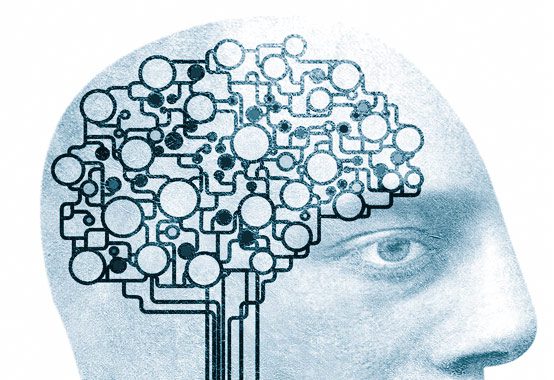Never Mind Humanity

One might think that if someone ever figured out how to create a mind—if the secret of human thought were ever revealed—explaining it would take more than a normal-sized book. But such is the promise of Ray Kurzweil’s new volume, which tackles the most perplexing riddle in the history of scientific investigation in a mere 282 pages (plus endnotes). The book might be dismissed on the bluster of its title alone, were it not the latest work from the famed futurist, inventor, and artificial-intelligence pioneer Ray Kurzweil, who was hired as a director of engineering at Google the month after the book’s release.
Kurzweil’s theory begins with the premise that the basic function of the mammalian brain is pattern recognition. Backed by scattered empirical evidence, he suggests that neurons are bunched into small groups, each of which can recognize very simple patterns in raw information from the senses. With hundreds of millions of these units working in concert, a simple, uniform learning method can build up to progressively more complex features and so tackle complicated cognitive tasks. Like our own perception, Kurzweil’s system is sensitive to context: for instance, it is more likely to recognize a smudged character as an “E” when it is preceded by the characters “appl” than by “banan.”
In contrast, early AI research began by assuming that the mind is inherently formal and computer-like, even in its most immediate manifestations—for example, that our perceptions strictly precede our interpretations of them because our eyes are like video cameras. Cognitive scientists have only recently begun to reverse this view, documenting the ways that our perceptions are intertwined with our interpretations of them, as in the apple/banana example. Although Kurzweil still views cognition as ultimately reducible to computation, his insistence on starting from intuitions about the mind itself, rather than about computers, is a welcome corrective to many of the dogmas of early AI.
The argument, however, is weakened by its exposition, which inadvertently demonstrates Kurzweil’s claim that simple ideas can come across as much more complicated than they really are. Kurzweil describes the formulas behind his ideas mainly through text and poorly labeled diagrams, avoiding almost any math, which is surely safe to use when accompanied by proper verbal explanations. Because the book tries to split the difference between lay readers and those who are already somewhat versed in AI, it leaves many question marks for both.
That much of the latter half of the book is little more than a quick-and-dirty rehash of his earlier work does not help. Kurzweil’s monograph on thought seems curiously thoughtless in places, and the prose is sprinkled with odd, flat sentences that ape the “Deep Thoughts” segments from “Saturday Night Live” of yore: “A common aphorism is, ‘You are what you eat.’ It is even more true to say, ‘You are what you think’.” “If you haven’t actually experienced ecstatic love personally, you have undoubtedly heard about it.” “The neocortex is a great metaphor machine, which accounts for why we are a uniquely creative species.” Later, immediately after reciting the dictionary definition of “metaphor,” Kurzweil abruptly asks, “Do you see any metaphors in Sonnet 73 by Shakespeare?”, then reproduces the sonnet. (In case you were wondering, yes, the sonnet does turn out to have some metaphors.)
The sophomoric attempts to describe metaphor point to the ultimate failings of what Kurzweil describes as his unified theory of mind—a theory whose power of explanation he repeatedly compares to those of Darwin and Einstein. He gives no account, for example, of a basic feature of perception, described elegantly by Emily Dickinson in a poem Kurzweil makes the opening epigraph to the book but does not seem to have fully thought through: “The Brain—is wider than the Sky— / For—put them side by side— / The one the other will contain … ” Perceptions do not simply categorize the world, as Kurzweil suggests, but experientially grasp it. But disembodied information, no matter how sophisticated, is not enough to create this experience—which is why computers today are no more capable of grasping the world than inert books or scrolls have been for the past three millennia.
Kurzweil simply waves this concern aside, arguing that qualities like these are “emergent properties” of the brain, and so will presumably arise from an emulation of human thought. The trouble is that, like mathematics, all of computation is already a way of formalizing and thus mimicking portions of thought, but that is not enough to allow computers to feel themselves thinking those thoughts. Perhaps Kurzweil’s system, which mimics a different portion of human thought, will somehow change this—but he offers no argument for why it will. His descriptions of his system as “symbolic” and “metaphorical” depend on the very leap his theory needs to explain: how does the brain move from being merely a piece of matter in the world, extending the organism’s ability to behave there in sophisticated ways, to a piece of matter that contains the world—or at least has the sense that it does?
The fact that Kurzweil ignores or even denies the great mystery of consciousness may help explain why his theory has yet to create a mind. In truth, despite the revelatory suggestion of the book’s title, his theory is only a minor variation on ideas that date back decades, to when Kurzweil used them to build text-recognition systems. And while these techniques have produced many remarkable results in specialized artificial-intelligence tasks, they have yet to create generalized intelligence or creativity, much less sentience or first-person awareness.
Perhaps owing to this failure, Kurzweil spends much of the book suggesting that the features of consciousness he cannot explain—the qualities of the senses and the rest of our felt life and their role in deliberate thought and action—are mostly irrelevant to human cognition. Of course, Kurzweil is only the latest in a long line of theorists whose attempts to describe and replicate human cognition have sidelined the role of first-person awareness, subjective motivations, willful action, creativity, and other aspects of how we actually experience our lives and our decisions.
Yet the kicker is that Kurzweil’s ultimate goal is to apply his theory not simply to creating intelligent machines but to our own minds, bringing them within the purview of computer engineers. The very world of feeling and experience that Kurzweil suggests has little relevance to understanding why we humans are the way we are is the same world he promises to deliver to us in ways faster, deeper, stronger, more vibrant, and more intense and mind-blowing than we can possibly imagine. In a series of books, lectures, and websites that have formed a sort of global Kurzweil brand, he has spelled out his vision of a future in which advances in biotechnology expand our lifespans indefinitely while neural implants enhance our cognitive abilities and gradually replace our meat-based brains.
With computers manipulating our neurons, he argues, we can experience anything we imagine. For instance, Kurzweil writes in his 2005 book The Singularity Is Near: When Humans Transcend Biology of the possibilities of virtual sex, in which you could download a program to instruct “nanobots in and around your nervous system [to] generate the appropriate signals for all of your senses: visual, auditory, tactile of course, even olfactory,” stimulating your nervous system into feeling a complete sensory experience as if you were having sex with your favorite celebrity or any other object of your desire. What’s love got to do with it?
Perhaps because Kurzweil sees fantasies like these as the greatest objects of our aspiration, it is not surprising to find in How to Create a Mind that his descriptions of the human nature he seeks to perfect seem so passionless and dreary. Despite paying lip service to artistic depictions of love and other elevated experiences, he refers to attraction as a “program,” says that love “exists to meet the [evolutionary] needs of the neocortex,” and explains the accompanying experiences of euphoria and yearning as “account[ed] for” by “high levels of dopamine and norepinephrine.” His descriptions of creativity and spirituality are even less inspiriting than this.
 This very paltriness is the real secret of Kurzweil’s theory, which promises to create a mind without really having to describe what it is like to have one. Perhaps the most important feature of human thought missing from Kurzweil’s theory is language. Describing it as but a useful “invention,” he gives no account of language’s distinctive role in human cognition—not simply in communicating our experiences and perceptions but in fundamentally shaping them, even constituting them.
This very paltriness is the real secret of Kurzweil’s theory, which promises to create a mind without really having to describe what it is like to have one. Perhaps the most important feature of human thought missing from Kurzweil’s theory is language. Describing it as but a useful “invention,” he gives no account of language’s distinctive role in human cognition—not simply in communicating our experiences and perceptions but in fundamentally shaping them, even constituting them.
Rather than flowing from some grand reflection about human nature, Kurzweil’s project begins from a conception of that nature whittled down to near nothing. Even for poets, words are always finally inadequate to our depths. Yet engineers whose views of human nature are the shallowest have anointed themselves as designers of the next stage in human evolution.
All of this might amount to nothing were it not for the fact that Kurzweil cannot be dismissed as a crank. Building on his previous AI innovations, he has a large audience for his prophecies, including prominent figures in industry and academia. In the end, these followers of “transhumanism” might just figure out how to pull off some of their goals. What some critics fear about this effort by Kurzweil and others to reengineer our bodies and minds is that, plagued by unintended consequences, the results could turn out quite other than predicted. Indeed—but should we be any more comforted by the possibility that the post-human nature they create might turn out just as they describe it?
Ari N. Schulman is a senior editor of The New Atlantis.
Comments